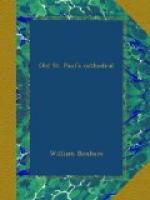Entering within the choir, the first monument—a marble altar tomb—was that of Thomas Ewer, or Evere, who was Dean for twelve years, and died in 1400. In a straight line with it, before the steps of the high altar, lay Robert Fitzhugh, Bishop 1431-1436, who, as the learned Chancellor of the University of Cambridge, was sent as an English delegate to the Council of Basel. Whilst he was there he was elected to the See of London, and consecrated at Foligno. He was an earnest labourer for the betterment of the poor clergy in his diocese. Immediately behind the high altar screen was the magnificent shrine of St. Erkenwald, and beside it the tomb of Dean Nowell, both of which are described hereafter (see pp. 24, 51). East of this again, at the entrance to the Lady Chapel, was the beautiful brass of Robert Braybrooke, Bishop 1381-1405. His was a troublous time, the time of the evil government of Richard II. The Bishop exerted himself with all his might to bring about righteous government, and to draw the king away from evil counsellors. But he also persuaded the citizens to keep the peace when they would have run into riot, and was all his life held in honour. He was fierce against the Lollards, hardly to be wondered at, as they were constantly affixing papers against current doctrines and doings on the doors of the cathedral. It was this bishop who rebuked the citizens for their neglect of the Feast of the Conversion of St. Paul, their patron saint, and he made arrangements for special services, which from that time were carefully observed. He also gave directions for more devout observance of St. Erkenwald’s Day, and set aside money from the See for the feeding of 15,000 poor people on that day in St. Paul’s Churchyard. Robert Preston, a grocer, left a rich sapphire to the shrine, to be used for rubbing the eyes of persons who were threatened with blindness, and Braybrooke gave orders that the clergy should appear on all these high festivals in their copes, that nothing might be lacking to do them honour. He offered no opposition to the deposition of King Richard II.: it was clearly inevitable. Braybrooke was a vigorous reformer of abuses, and denounced the profanation of the church by traffickers, shooting at birds inside, and playing at ball.
Alongside the Lady Chapel, on the north side, was the chapel of St. George. We will now pass from it back by the north aisle. By the pillar north of the altar screen was the tomb of Sir Thomas Heneage. He was Vice-Chamberlain to Queen Elizabeth, and all his life was much trusted by her in matters of foreign diplomacy, though he sometimes got into trouble by taking too much on himself. His daughter Elizabeth was ancestress of the Earls of Winchelsea. He died in 1595.




